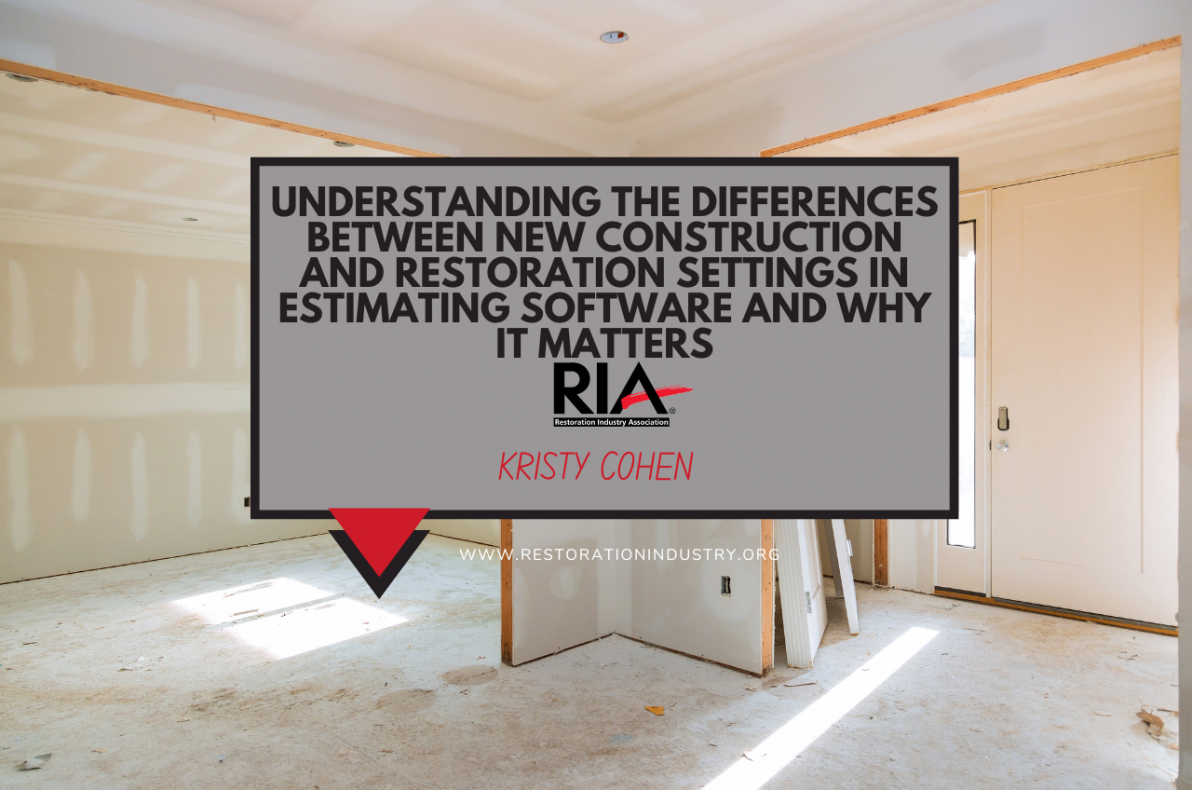Understanding the Differences Between New Construction and Restoration Settings in Estimating Software and Why it Matters

Restoration is not new construction. The construction industry focuses on new builds, renovations, and expansions, while the restoration industry specializes in repairing, remediating, and returning damaged structures to their pre-loss condition after events like water, fire, mold, or storm damage. Restoration requires specific safety training, personal protective equipment, and other procedures, all of which entail extra costs that are not typically incurred in new construction.
Restoration typically involves the complex process of reassembling some but not all of a structure that has been damaged. Restorers incur unique costs associated with returning properties to their pre-loss condition when attempting to match materials and finishes and tying new materials into an existing structure. Restorers often have to match pre-existing conditions while rarely having the original specifications, engineering, or blueprints, and when they do have the original specifications, it is rare that they comply with updated regulations, building codes, or current building materials.
In some cases, accessibility to or within the structure may be difficult due to the need to navigate around the occupant’s personal property, and limitations on working hours imposed by community associations and property managers. Additionally, fires and floods often damage properties in unique ways, and each requires a customized repair approach.
In contrast, new construction projects are typically planned, structured, and executed over a longer period and often present economies of scale that are generally impossible in restoration. In new construction, repetitive tasks can be performed by crews who specialize in one narrow task, particularly in mass production construction. Builders who perform new construction are better able to predict the costs of their work and often enjoy lower labor and material costs because they are able to buy in bulk. Restorers rarely enjoy any of those benefits and face many obstacles to efficiency that are absent in new construction.
What Happens When “New Construction” Price Settings are Globally Applied
New construction cost assumptions do not fully reflect real-world restoration costs. However, some estimating software includes “new construction” price settings in addition to Restoration/Service/Remodel settings. When new construction settings are globally applied to restoration projects, they assume ideal conditions and more efficient work, stripping out the costs associated with the unique complexities of restoration.
- The new construction setting assumes efficient tasks and removes allowances for inefficient labor costs and logistical challenges of repairing an existing structure.
- These settings also assume a clean slate and omit costs for emergency services, damage mitigation, demolition, and debris removal.
- Estimates using this setting no longer account for the added time and labor needed to match existing materials, work in confined spaces, or deal with challenging site access.
- New construction settings increase assumed labor productivity rates for new builds, which significantly lowers the estimated costs.
Simply put, global, arbitrary adjustments using new construction price settings can make restoration estimates inaccurate, negatively impacting property owners and the restorers working to return their properties to their pre-loss condition.
Each restoration project is unique, and the actual costs for labor, material, and equipment are impacted by variables that no software can globally predict. The largest estimating software providers reiterate in their end-user license agreements that their data should be used as a starting point for the creation of an estimate and that users of the software agree not to prohibit or preclude deviations from the software data when deviation is warranted based on specific costs and circumstances of the actual project.
It is important to remember that:
- Each project is different with unique variables that impact cost.
- Insurance policies require carriers to pay “reasonable” and “customary” prices, not artificially adjusted ones.
- There is a shared responsibility for restorers to set prices that reflect true labor, material, and equipment costs — and carriers to respect those realities.
Restoration requires expertise, adaptability, and respect for real-world conditions. Arbitrarily applying global “new construction” price settings to restoration work leads to inaccurate estimates and ultimately hurts both the policyholder and the restorers working to serve them.
The RIA’s Advocacy & Government Affairs works to advocate for peer-reviewed positions that promote fair practices and policies that support a restorer’s ability to perform services and meet the needs of their customers. The RIA advocates for these positions with third parties whose policies, practices, and regulations may impact restorers, including: legislators, regulators, third-party administrators & consultants, adjusters, pricing software platforms, and insurance carriers.
The RIA’s position statement on New Construction Price Lists is available for download at training.restorationindustry.org/pricing-position-statements.
To learn more and get involved with RIA’s advocacy work, visit restorationindustry.org.
